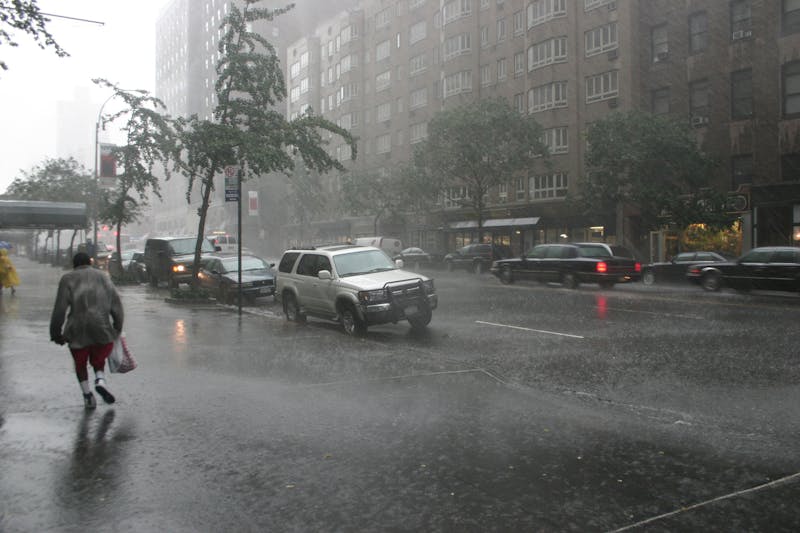
Construction workers in New York face inherently dangerous working conditions, but adverse weather can further amplify these risks, leading to serious accidents and injuries. New York's diverse and often extreme weather patterns — from icy winters and heavy rains to scorching summers — create unique challenges for construction sites.
The Role of Weather in NYC Construction Site Accidents
Weather can directly or indirectly contribute to construction site accidents by altering working conditions and creating hazards that may not be present under normal circumstances. Key weather-related factors that increase accident risks include reduced visibility, unstable surfaces, slippery conditions, and exposure to extreme temperatures.
Employers are legally obligated under the Occupational Safety and Health Administration (OSHA) regulations to take reasonable steps to address weather-related hazards and protect workers. Failure to do so may lead to liability for injuries sustained by workers.
Common Weather Conditions That Cause Construction Accidents in NY
Rain and Wet Conditions
Rain can create slippery surfaces, leading to falls from heights, slips on ground-level surfaces, and scaffolding collapses. Wet tools and machinery can also malfunction or cause electrical hazards. Drainage issues at construction sites may result in standing water, increasing risks of slips and even drowning in severe cases.
Snow and Ice
New York winters bring snow and ice, which create treacherous conditions for construction workers. Key risks include:
- Falls: Snow-covered surfaces and icy scaffolding or ladders are leading causes of slips and falls on construction sites.
- Structural Collapses: Accumulated snow and ice can overload roofs, scaffolding, or temporary structures, leading to catastrophic collapses.
- Frostbite and Hypothermia: Prolonged exposure to subzero temperatures without adequate protective gear can result in serious health issues.
High Winds
High winds are particularly dangerous for sites involving cranes, scaffolding, or materials stored at height. Risks include:
- Falling Objects: Tools, construction materials, or debris can be blown from heights, causing severe injuries to workers below.
- Equipment Instability: Wind can destabilize cranes, aerial lifts, and scaffolding, increasing the likelihood of collapses.
- Loss of Balance: Workers performing tasks at height may lose their balance in strong gusts.
Extreme Heat and Sun Exposure
During the summer months, construction workers are exposed to heat-related risks such as dehydration, heatstroke, and sunburn. Long-term exposure to the sun without protective measures can also increase the risk of skin cancer. Heat can impair concentration and reaction times, increasing the likelihood of errors and accidents.
Fog and Reduced Visibility
Fog and other weather conditions that reduce visibility increase the likelihood of collisions between heavy machinery and vehicles on-site. Workers may also be unable to see hazards clearly, such as holes, uneven surfaces, or falling objects.
Lightning and Thunderstorms
Lightning poses a direct risk to workers operating cranes, aerial lifts, or working on scaffolding. Construction sites with exposed metal structures are particularly vulnerable. Thunderstorms can also cause flash floods, endangering workers in low-lying areas.
OSHA Standards for Addressing Weather Hazards on Construction Sites
OSHA requires employers to take reasonable steps to mitigate the risks posed by weather conditions. Some key regulations include:
- Fall Protection (29 CFR 1926.501): Employers must provide fall protection equipment and ensure it is used, especially during slippery conditions caused by rain, snow, or ice.
- Personal Protective Equipment (PPE) (29 CFR 1926.95): Workers must be provided with weather-appropriate PPE, such as insulated gloves, waterproof boots, and visibility vests.
- Hazard Communication (29 CFR 1926.59): Employers must inform workers of specific weather-related risks and how to avoid them.
- Cranes and Derricks Safety (29 CFR 1926.1400): Strict guidelines govern the safe operation of cranes in high winds.
Failure to adhere to these standards may make employers or contractors liable for construction site injuries caused by weather conditions.
Who is Liable for Weather-Related Construction Site Accidents in New York?
Liability for weather-related construction site accidents depends on the circumstances of the incident and the parties responsible for mitigating risks.
Employers
Employers are required to ensure safe working conditions, even in adverse weather. This includes halting work in unsafe weather, providing PPE, and addressing hazards caused by rain, ice, or wind. Failure to meet OSHA standards may result in liability for worker injuries.
Contractors and Subcontractors
Contractors and subcontractors are responsible for maintaining a safe job site. If they fail to implement weather-related safety measures or properly secure equipment and materials, they may be held liable.
Property Owners
If a property owner fails to address hazards like flooding caused by inadequate drainage or falling debris due to poor tree maintenance, they may share liability for injuries on their property.
Third Parties
Construction equipment manufacturers or suppliers may be held liable if defective machinery contributes to accidents during inclement weather. For example, a faulty crane unable to withstand high winds could lead to a catastrophic incident.
How to Prevent Weather-Related Construction Accidents
Employers, contractors, and workers can reduce the risks of weather-related accidents by implementing the following measures:
- Weather Monitoring: Regularly check weather forecasts to anticipate hazardous conditions and halt work when necessary.
- Training: Provide workers with training on recognizing and responding to weather-related hazards.
- Site Preparation: Clear snow, ice, and debris promptly and secure tools and equipment during high winds.
- PPE: Supply weather-appropriate PPE, such as insulated clothing, rain gear, and slip-resistant footwear.
- Temporary Structures: Ensure scaffolding, cranes, and other temporary structures are properly secured and inspected.
Compensation for Weather-Related Construction Injuries in New York
Injured construction workers may be entitled to compensation for weather-related accidents through:
1. Workers’ Compensation
Workers’ compensation benefits provide medical expenses, lost wages, and disability benefits to injured workers, regardless of fault. Based on this, these benefits may not fully cover all damages.
2. Third-Party Claims
If a third party (e.g., a contractor, property owner, or equipment manufacturer) contributed to the accident, the injured worker may file a personal injury lawsuit for additional compensation, including pain and suffering and lost future earnings.
How an Experienced New York Construction Accident Attorney Can Help
Navigating the legal complexities of weather-related construction accidents can be challenging. An experienced construction accident attorney can:
- Investigate the incident and identify liable parties.
- Collect evidence, such as weather reports, site conditions, and witness statements.
- Negotiate aggressively with insurance companies to maximize compensation.
- File a personal injury lawsuit if necessary to recover full damages.
Get Our Top-Rated New York Construction Accident Lawyer on Your Side
If you have been injured in a construction accident in New York, trust construction accident lawyer Michael S.Lamonsoff “The Bull” and his teamto fight for your rights. At The Law Offices of Michael S. Lamonsoff, PLLC, we don’t back down against powerful construction companies and large insurance corporations.
We prepare every case as if it were going to trial, ensuring that insurance companies cannot control the outcome or offer you an inadequate settlement. With our aggressive litigation strategy, we will fight to get you the highest possible compensation for your injuries and losses. We also have dedicated Portuguese and Spanish-speaking teams are ready to assist you. To schedule your free consultation, call us at 212-962-1020 or fill out this online contact form.


